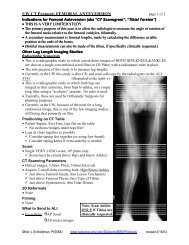Ankle and Foot 47 - Department of Radiology - University of ...
Ankle and Foot 47 - Department of Radiology - University of ...
Ankle and Foot 47 - Department of Radiology - University of ...
You also want an ePaper? Increase the reach of your titles
YUMPU automatically turns print PDFs into web optimized ePapers that Google loves.
<strong>47</strong> <strong>Ankle</strong> <strong>and</strong> <strong>Foot</strong> 2211 <strong>47</strong><br />
A B C<br />
Figure <strong>47</strong>-6. Straight axial images through the ankle<br />
<strong>and</strong> hindfoot, proximal (A) to distal (F). A, Proximal to<br />
syndesmosis. Fi, fibula; Ti, tibia. B, Through the<br />
syndesmosis (arrow). Fi, fibula; Ti, tibia. C, Through the<br />
top <strong>of</strong> the mortise. LM, lateral malleolus; MM, medial<br />
malleolus; Ta, talus. D, Through the sustentaculum tali<br />
(ST). Ca, calcaneus; N, navicular; Ta, talus; TNJ,<br />
talonavicular joint. E, Through the level where the<br />
calcaneus gets close to the navicular (arrowhead) but<br />
does not normally form a joint. If there were an<br />
articulation here, or osseous bridging, that would be<br />
tarsal coalition. Ca, calcaneus; Cu, cuboid. Numerals<br />
indicate cuneiforms. F, Through the calcaneocuboid<br />
joint (CCJ). Ca, calcaneus; Cu, cuboid. Roman numerals<br />
indicate metatarsals.<br />
D E F<br />
over several 3-mm slices (see Fig. <strong>47</strong>-8A). As the posterior<br />
facet ends the middle facet begins, as defined by the sustentaculum<br />
tali (see Fig. <strong>47</strong>-8B). When the oblique coronal<br />
slices are properly angled, the middle facet appears horizontally<br />
oriented (see Fig. <strong>47</strong>-8C). The sinus tarsi is the<br />
cone <strong>of</strong> s<strong>of</strong>t tissues directly lateral to the middle facet.<br />
Anterior to the subtalar joint, the round head <strong>of</strong> the talus<br />
is seen as a circle forming the talonavicular joint (see Fig.<br />
<strong>47</strong>-8D). This demarcates the Chopart joint, the division<br />
between the hindfoot <strong>and</strong> midfoot.<br />
• <strong>Ankle</strong> Tendons<br />
There are 10 tendons that cross the ankle joint. For imaging<br />
purposes, these tendons can be clustered into four groups<br />
based on their anatomic locations, as illustrated by the<br />
colored curved lines drawn atop three-dimensional CT<br />
images in Figure <strong>47</strong>-9. The anterior tendons are the anterior<br />
tibial, the extensor hallucis longus, <strong>and</strong> the extensor<br />
digitorum longus (see Fig. <strong>47</strong>-9A). Posteriorly, there are the<br />
Achilles <strong>and</strong> plantaris tendons (see Fig. <strong>47</strong>-9B). Laterally,<br />
the peroneus longus <strong>and</strong> peroneus brevis tendons pass<br />
under the lateral malleolus (see Fig. <strong>47</strong>-9C). Medially, the<br />
posterior tibial <strong>and</strong> flexor digitorum longus tendons pass<br />
under the medial malleolus, whereas the flexor hallucis<br />
longus passes under the sustentaculum tali (see Fig. <strong>47</strong>-9D<br />
<strong>and</strong> E).<br />
On MRI, ankle tendons are best appreciated in cross<br />
section in the direct axial plane (Fig. <strong>47</strong>-10). The oblique<br />
coronal plane (Fig. <strong>47</strong>-11) is a good secondary plane to<br />
observe the medial <strong>and</strong> lateral tendons as they course<br />
under the malleoli. Normal tendons should appear uniformly<br />
black on all imaging sequences <strong>and</strong> have a sharply<br />
defined interface with adjacent fatty s<strong>of</strong>t tissues. Any<br />
increased signal in a tendon on a T2-weighted image indicates<br />
the presence <strong>of</strong> pathology, typically an intrasubstance<br />
tear. In addition, more than a trace amount <strong>of</strong> fluid around<br />
an ankle tendon is abnormal, indicating inflammation or<br />
some other pathologic process. The exception to this is the<br />
flexor hallucis longus, which can normally contain some<br />
fluid in its tendon sheath.<br />
• Anterior Tendons<br />
Normal Anatomy<br />
The normal anterior tibial tendon serves as a useful internal<br />
st<strong>and</strong>ard with which to compare the size <strong>of</strong> the other<br />
ankle tendons. The anterior tibial is normally the largest<br />
Ch0<strong>47</strong>-A05375.indd 2211<br />
9/9/2008 5:33:23 PM
















